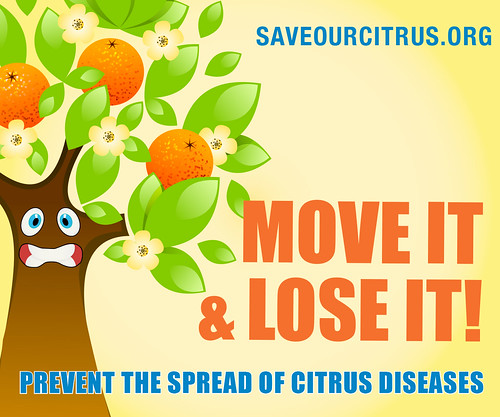
Help Save Our Citrus -- visit www.saveourcitrus.org or follow us on Facebook and Twitter.
Soon, citrus producing states across America, including Arizona, California, Florida, Louisiana and Texas, will be full of fresh citrus. But gone are the days of sharing the fruit trees or seeds with friends and family out of state or even in the next county. It’s no longer as simple as packing it up and shipping it, or buying a citrus tree at a road side stand to bring home.
You’ve heard the saying “move it or lose it.” When it comes to citrus trees, it’s “Move It AND Lose It.” When you move citrus trees, you risk losing America’s citrus altogether – think breakfast with no fresh oranges, grapefruit or even juice.
Moving citrus trees is the fastest way that citrus diseases are spread. Four serious citrus diseases found in the United States include Huanglongbing (also known as citrus greening or HLB for short), citrus canker, citrus black spot and sweet orange scab. Learn more about each disease by visiting the What Are the Diseases section of the Save Our Citrus website.
When infected trees, fruit, clippings, equipment or even workers are moved to a new area, the disease comes with them. It’s not just commercial citrus that is susceptible to these diseases. Homegrown citrus trees can easily become infected and spread disease.
Move It AND Lose It: Five Things You Need to Know
- Be Aware of Quarantines. Knowing where quarantines are is key to preventing the spread of disease. For example, if your county is under quarantine for both the Asian citrus psyllid and citrus greening, this means that citrus cannot leave these counties. No citrus plants, fruit, equipment or items made with citrus (such as floral arrangements, wreaths, potpourri or seasonings like kaffir lime leaves) may be moved from quarantined areas. Not only are you risking spreading citrus diseases by transporting citrus outside of these areas, but it’s also against the law. Check our interactive quarantine map to learn what areas are under quarantine.
- Inspect Citrus Plants Regularly for Diseases and Insects. Check citrus plants for signs of Huanglongbing and other citrus diseases. If you detect an infected plant, report it immediately.
- Keep Homegrown Citrus at Home. Help reduce the spread of citrus diseases by not moving your homegrown citrus plants or fruits. Even if a tree looks healthy, don’t move it. This is the simplest yet most important thing for all Americans to do to protect our citrus.
- Check Citrus Plant Suppliers. Be a savvy buyer. Only buy citrus plants from a reputable, licensed nursery. Commercial fruit packers, Internet shippers and roadside vendors within regulated states should be able to show that they are in compliance with the federal quarantine. Before you buy, ask the vendor if their product is in compliance. If you buy a plant that is disease-free, you’ll have a much healthier, more productive tree.
- Avoid Fines and Penalties. If you knowingly purchase citrus trees in violation of quarantine regulations and requirements, the penalties could range from $1,100 to $60,000 per violation. If you suspect citrus trees are being moved improperly, report your concerns to your USDA State Plant Health Director’s office; you can find contact information online at www.aphis.usda.gov/StateOffices.
No comments:
Post a Comment